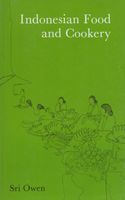Advertisement
Kunyit
By Sri Owen
Published 1980
Curcuma domestica (Java, kunir). Turmeric. Many of the dialect names for this plant resemble the Indonesian word ‘kuning’, which means yellow, and certainly yellowness is one of the most obvious characteristics of turmeric. Yellow is traditionally a sacred colour in the East and India, and Nasi Kuning (Yellow Rice) is still thought of as a dish for celebrations. ‘Curry,’ says Burkill magisterially, ‘is impossible without turmeric,’ and it imparts not only its colour but also its pleasing, pungent flavour to quite a number of Indonesian dishes. The part you eat is the rhizome, which looks pretty much like ginger, but in Britain it is, I think, always sold in dried or powdered form. If you can get fresh kunyit, cut off a small piece, peel it, and crush it with the other spices, garlic, etcetera in your cobek. LAOS, Languas galanga (in Malaysia and elsewhere, lengkuas or variant spellings). This is usually translated into English as galingale, again with many variant spellings. Tennyson made it grow in the land of the Lotos-Eaters, no doubt because he liked the sound of the word. The Oxford English Dictionary traces the descent of the name from Chinese via Arabic, and says that galingale is the aromatic root of plants of the genera Alpinia and Kaempferia, ‘formerly much used in medicine and cookery’. ‘Formerly’ is correct perhaps in English usage, since the Dictionary’s earliest citation of ‘galingale’ dates from about AD 1ooo and occurs in a recipe in Saxon Leechdoms that used pepper, galingale and ginger.


